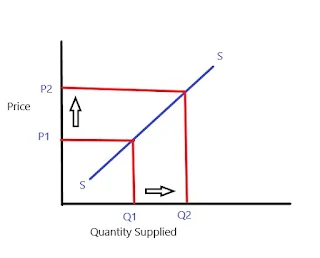Elasticity of supply
According to Professor Thomas,” the study of a commodity is said to be elastic when as a result of a change in price, the supply changes sufficiently as a quick response. Contrarily, if there is no change or negligible change in supply or supply pays no response it is elastic.”It can be calculated by dividing the percentage change in the quantity supplied by the percentage change in the price of the product.
Symbolically,
Where,
∆s= change in quantity supplied
∆p= change in price
P= initial change in price
S= initial change in supply
Types/degrees of elasticity of supply
Perfectly elastic supply (Es=∞)
In the above figure price and quantity supplied are shown along y-axis and x-axis respectively. When the change in price is in negligible amount then the quantity supplied changes in a heavy amount. PS is the supply curve which is perfectly elastic, i.e. Es=∞ .
Perfectly inelastic supply (Es=0)
In the above figure, Q1S is perfectly inelastic supply. It is parallel to the y-axis. It shows that at price OP1, OP2, OP3 the quantity supplied remains unchanged, i.e OQ1.
Unitary elastic supply (Es=1)
In the above figure price and quantity supplied are shown along y-axis and x-axis respectively. It shows that the ratio of change in quantity supplied is equal to the ratio of change in price. SS is supply curve which is unitary elastic. I.e. Es=1
Relatively elastic supply (Es>1)
In the above figure price and quantity supplied are shown along y-axis and x-axis respectively. It shows that the ratio of change in quantity supplied is greater than the ratio of change in price. SS is supply curve which is relatively elastic.Es>1
Relatively inelastic supply (Es<1)
It can be explained by the help of the following figure:
In the above figure price and quantity supplied are shown along y-axis and x-axis respectively. It shows that the ratio of change in price is greater than the ratio of change in quantity. SS is supply curve which is relatively inelastic I.e; Es<1







0 Comments
If this article has helped you, please leave a comment.